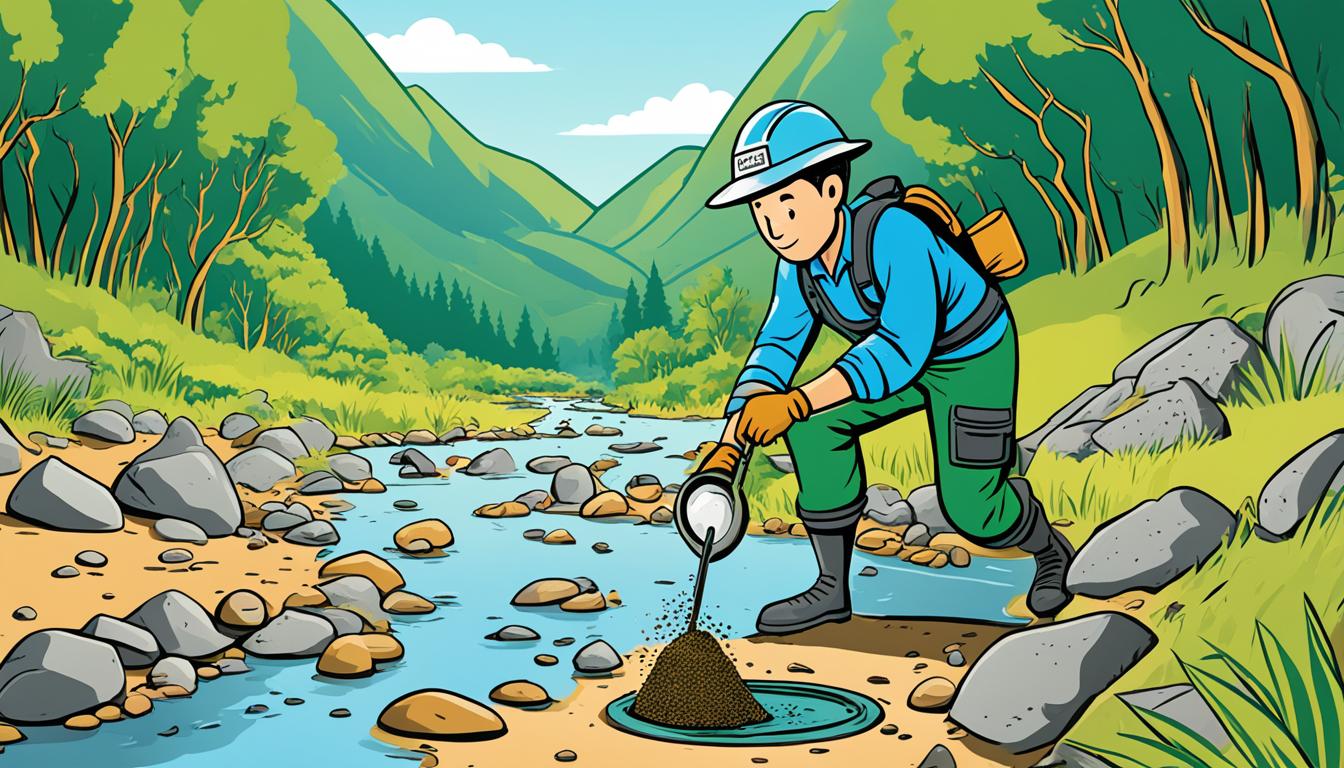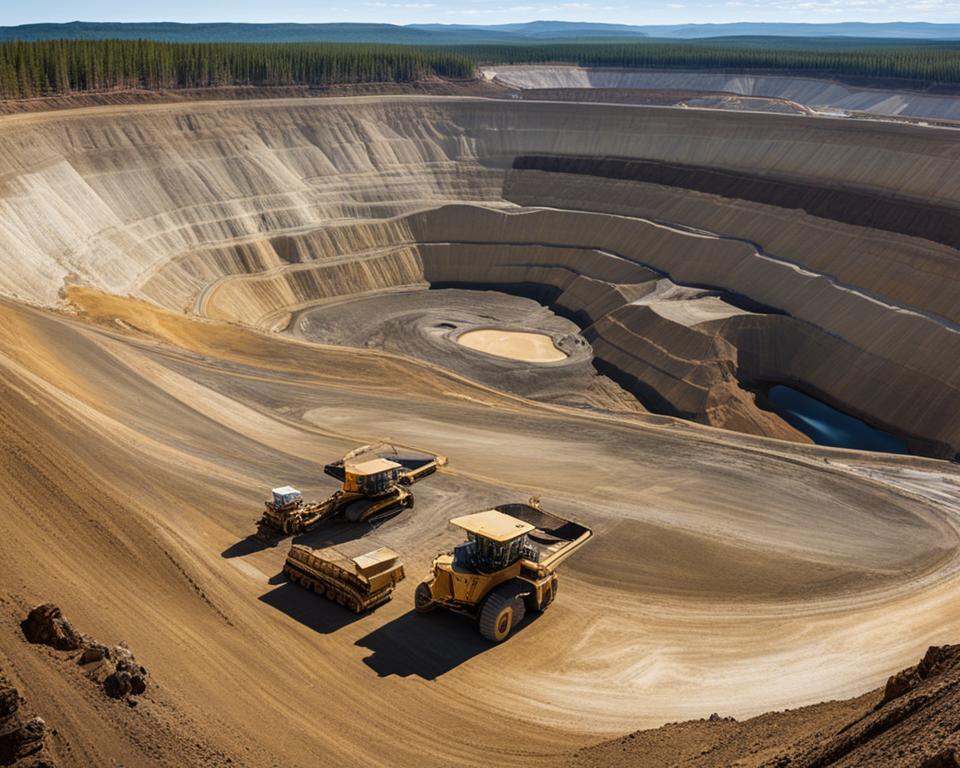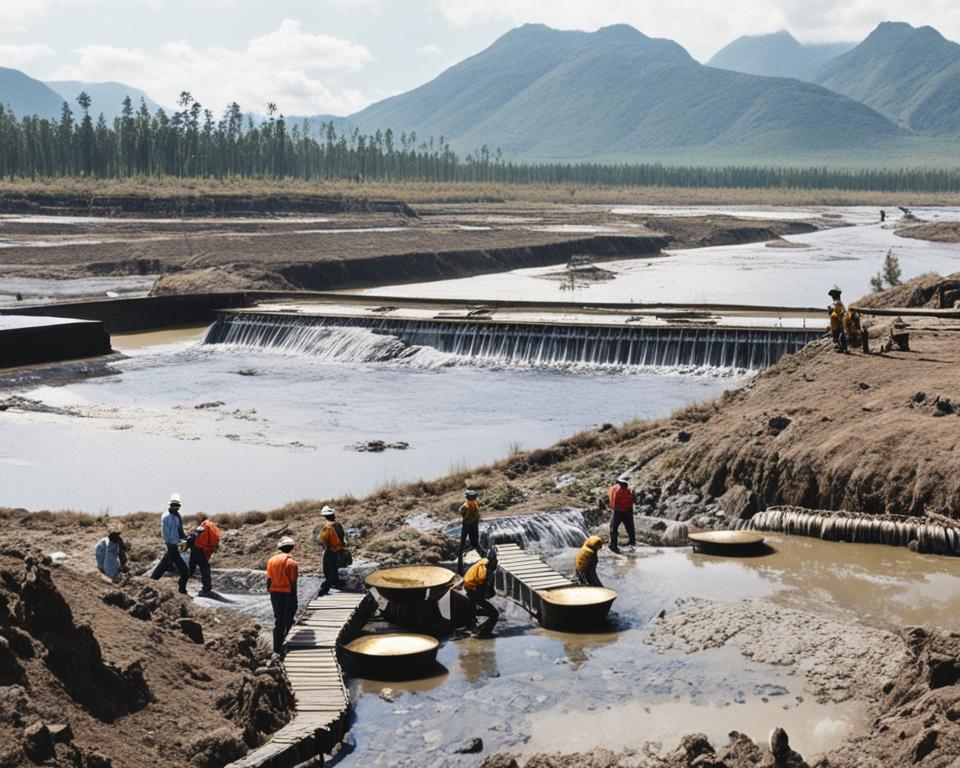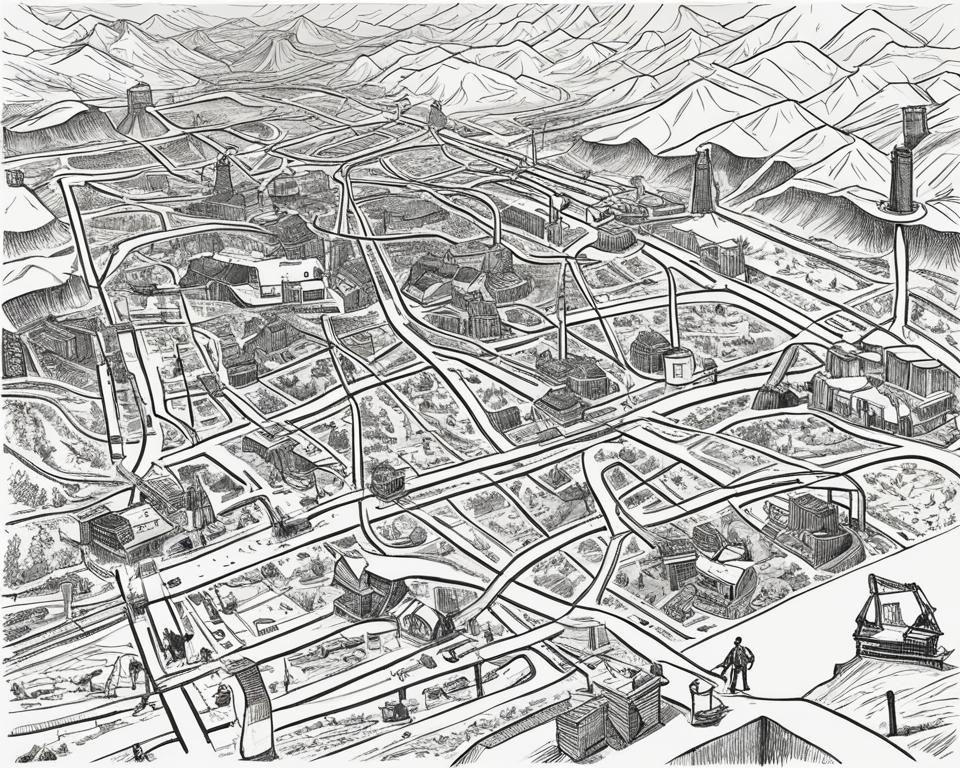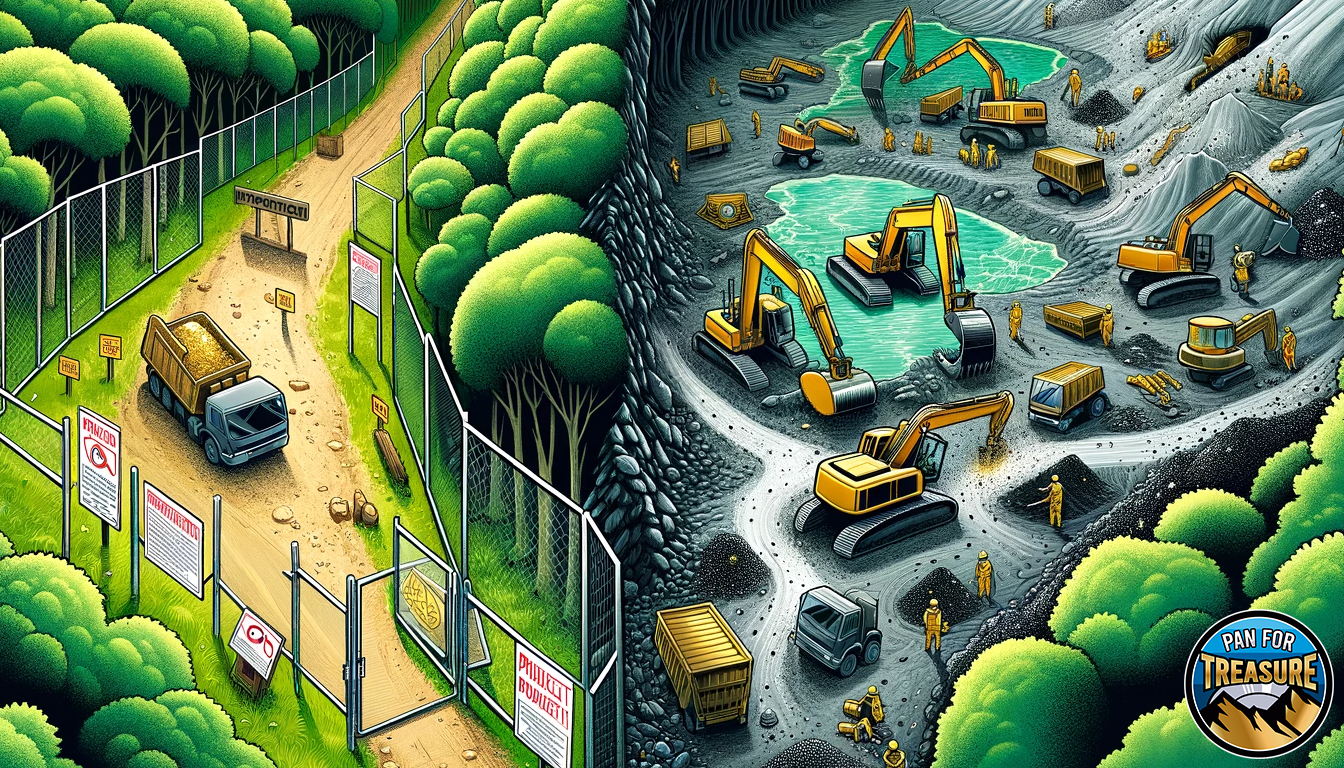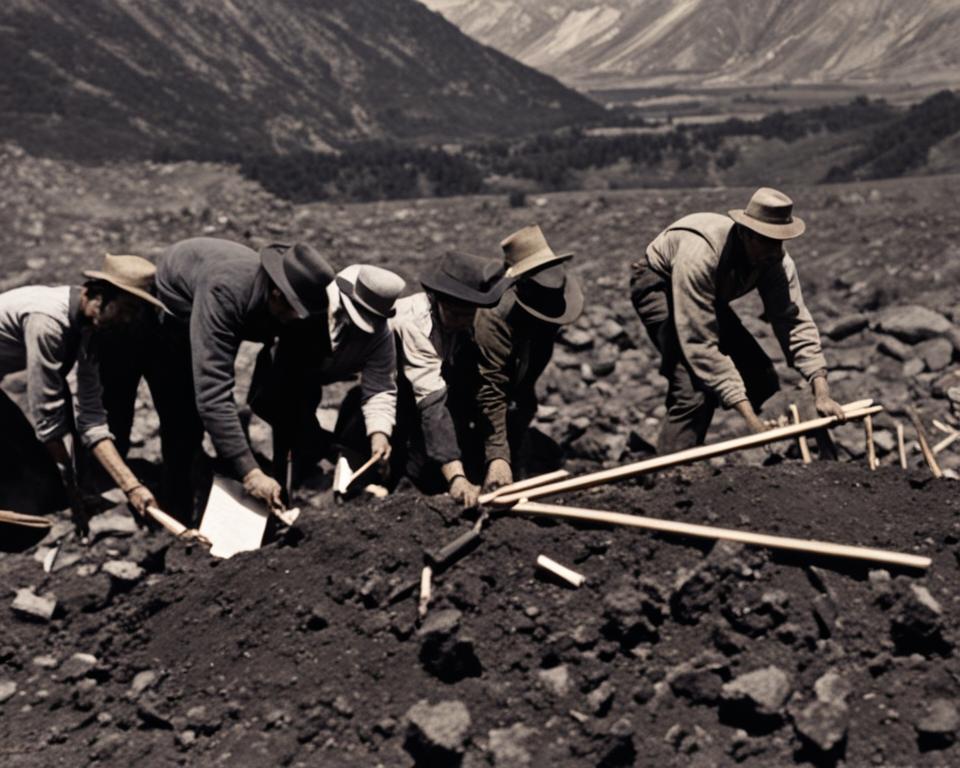
Claim staking is a fundamental process in the world of gold mining. If you have ever wondered how individuals and companies secure mining rights and explore potential mineral deposits, this article will guide you through the ins and outs of claim staking process.
Whether you are an aspiring miner or an investor looking to enter the mining industry, understanding the basics of claim staking is crucial. This process involves securing rights to potential gold mining claims on federal lands managed by the Bureau of Land Management (BLM) or Forest Service.
Claim staking is not a one-step process but rather a series of critical steps that ensure the validity of the claim and adherence to state statutes and regulations. From prospecting to writing notices, conducting land status searches, and filing paperwork, each step plays a vital role in securing and maintaining a mining claim.
Key Takeaways:
- Claim staking is the process of securing rights to potential gold mining claims.
- It involves several key steps such as prospecting, conducting land status searches, and filing notices.
- Claims must adhere to state statutes and regulations to be considered valid.
- Professional claim staking services can provide assistance throughout the process.
- Understanding ongoing obligations, like annual fees, is crucial for successful claim staking.
Prospect and Find an Area of Interest
Prospecting is an essential first step in the claim staking process, as it involves identifying and exploring an area of interest for potential mineral deposits. To successfully prospect, a combination of desktop studies and on-the-ground techniques can be employed.
Desktop Studies
Desktop studies involve comprehensive research using historical records, reports, and geological data to analyze the potential mineralization of a specific area. By examining geological maps, mineral surveys, and literature, prospectors can gain valuable insights into the geology, mineralogy, and historical mining activities of a given region.
Desktop studies are particularly useful in narrowing down the search area and identifying regions with known mineral occurrences or favorable geological settings. This information guides further exploration and helps prospectors make informed decisions.
On-The-Ground Prospecting
On-the-ground prospecting involves physically examining the selected area to gather firsthand information about the presence and quality of mineral deposits. Two commonly used techniques for on-the-ground prospecting are soil sampling and rock chip sampling.
Soil Sampling:
Soil sampling involves collecting samples of surface soil from different locations within the area of interest. These samples are then analyzed for geochemical properties, such as the presence of specific minerals or elements associated with mineralization. Soil sampling helps identify anomalous areas that may warrant further investigation.
Rock Chip Sampling:
Rock chip sampling entails collecting small rock samples from outcrops, structures, or mineralized zones within the prospecting area. These samples are analyzed to determine their mineral composition and grade. Rock chip sampling provides valuable information about the type and quality of minerals present in the area, aiding in the assessment of potential economic viability.
By combining the findings from desktop studies and on-the-ground prospecting, prospectors can build a comprehensive understanding of the prospecting area. This knowledge forms the basis for making informed decisions regarding claim staking and investment in further exploration activities.
| Prospecting Techniques | Description |
|---|---|
| Desktop Studies | Researching historical records, reports, and geological data to analyze the potential mineralization of a specific area. |
| Soil Sampling | Collecting surface soil samples from different locations within the area of interest and analyzing them for geochemical properties. |
| Rock Chip Sampling | Collecting small rock samples from outcrops, structures, or mineralized zones within the prospecting area to determine their mineral composition and grade. |
Conduct Land Status Searches
Before staking a mining claim, conducting thorough land status searches is crucial to ensure the area of interest is open for mineral entry and has no active competing claims. This research plays a vital role in verifying the availability of the land for claiming and helps avoid potential conflicts with other claimants.
To perform land status searches, there are several methods that can be employed:
- Checking Online Databases: Utilize online resources and databases that provide information on land status and whether it is open for mineral entry. These platforms may include the Bureau of Land Management (BLM) or Forest Service websites, where you can access various tools and maps.
- Contacting BLM or Forest Service: Reach out directly to the BLM or Forest Service offices to inquire about the land status and confirm if it is open for mineral entry. They can provide valuable insights and guidance on the process of conducting land status searches.
- Consulting with Professionals: Seek assistance from professionals who specialize in land research and claim staking. They possess the expertise and knowledge to navigate the complexities of land status searches and can provide valuable advice to prevent any potential issues.
By conducting comprehensive land status searches, you can ensure that the area you intend to stake is available for claiming and minimize the risk of competing claims. This research serves as a crucial foundation for successful claim staking and helps pave the way for further exploration and potential mining operations.
Write Notice of Location(s)
Once an area of interest is identified, the next crucial step in the claim staking process is to write a Notice of Location. This document serves as the formal declaration of intent to claim a specific mineral deposit, whether it’s a lode, placer, mill site, or tunnel site. Writing a comprehensive and accurate Notice of Location is essential to establish your rights and comply with state statutes and regulations.
When crafting the Notice of Location, it’s vital to follow the specific requirements set by each state. These requirements may include including necessary information such as your name, contact information, the type of mineral deposit being claimed, and a detailed description of the claim’s location. Some states may also require the inclusion of maps or diagrams illustrating the claim boundaries.
Furthermore, it’s important to consider who will hold the mineral rights to the claim. In the United States, only individuals who are US citizens and at least 18 years old, as well as US-based corporations, are eligible to hold mineral rights. This consideration ensures that the claim is valid and legally enforceable.
Writing a thorough and accurate Notice of Location is crucial to the success of your mining claim. Properly documenting the location and type of mineral deposit being claimed establishes your rights and protects your interests in the future.
Example Notice of Location
Notice is hereby given that I, John Smith, a US citizen of legal age, hereby claim a lode mining deposit located in Mineral County, Nevada, known as the Smith Lode. The claim is bounded by the following descriptions:
- Starting at the northwest corner of section 23, township 30 north, range 18 east, Mount Diablo Meridian;
- Thence south 500 feet to the northeast corner of the Smith Lode;
- Thence west 1,500 feet to the southwest corner of the claim;
- Thence north 500 feet to the northwest corner of the claim;
- Thence east 1,500 feet to the point of beginning.
The Smith Lode consists of approximately 20 acres and is located within the boundaries of the public land survey system (PLSS). The mineral rights to this claim are held exclusively by John Smith.
Any conflicting claims or objections must be filed within 90 days from the date of this Notice. Failure to do so will result in the relinquishment of any rights to the Smith Lode.
Place Corner Markers and Location Monuments
Once the Notice of Location has been written, it is imperative to adhere to the staking regulations of the Western States by placing corner markers and location monuments on the ground. These markers and monuments serve as physical indicators of the claim boundaries and are crucial for the validity of the claim. Compliance with the specific requirements outlined by each Western State ensures the claim’s recognition by both county and Bureau of Land Management (BLM) offices.
The size and type of corner markers and location monuments can vary among different Western States, as each state has its own staking regulations. For example, some states may require specific dimensions for claim posts, while others may have different requirements for corner markers and endlines. It is essential to familiarize oneself with the specific regulations governing the state in which the claim is being staked to ensure proper compliance.
| State | Corner Marker Requirements | Location Monument Specifications |
|---|---|---|
| Arizona | Wood posts with a minimum diameter of 2 inches and a height above ground of at least 4 feet. | Monuments made of durable materials such as concrete or metal, with a minimum size of 3 inches by 3 inches at the top surface. |
| California | Rebar or iron pipe corner markers, with a minimum height above ground of 3 feet. | Monuments made of durable materials, such as stone or concrete, with dimensions of at least 12 inches by 12 inches at the base and a height above ground of 4 feet. |
| Nevada | Wooden posts or iron rods with a minimum height of 3 feet above ground. | Durable materials such as concrete or metal, with a minimum size of 24 inches by 24 inches at the base and a height above ground of 4 feet. |
Ensuring the proper placement and type of corner markers and location monuments is crucial because they serve as visual representations of the claim boundaries, helping prevent any encroachment or disputes with neighboring claims. They also provide clear indicators to government authorities responsible for managing and overseeing mining claims, such as the county and BLM offices.
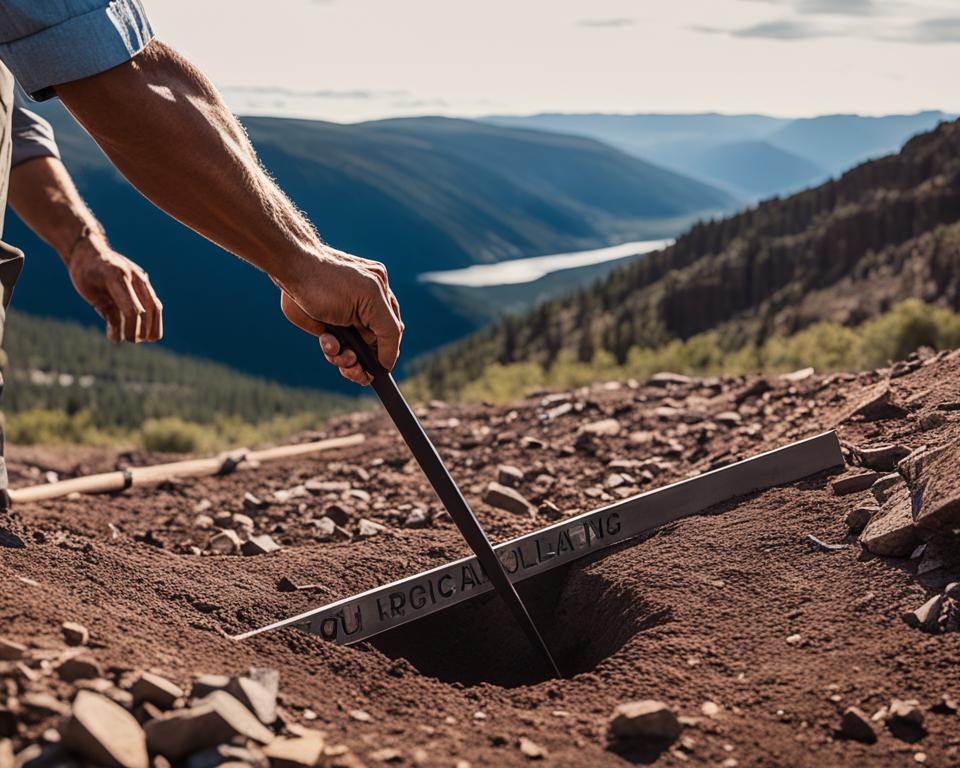
In addition to securing the claim boundaries, corner markers and location monuments contribute to the overall safety and organization of the mining site. They help miners and stakeholders navigate the area, preventing accidental trespassing on adjacent claims. By clearly demarcating the claim’s extent, these markers instill confidence and transparency in the mining operations.
File Notice of Location(s) with Appropriate Authorities
Once the necessary steps for claim staking have been completed, it is crucial to file the Notice of Location with the relevant authorities to ensure the claim’s official registration. This process involves submitting the required documentation and paying the recording fees to the appropriate county office.
By filing the Notice of Location, you provide legal notice of your claim to the county and establish your ownership rights. This step is essential for protecting your interests and preventing potential conflicts with other claimants.
Additionally, it is important to file a copy of the Notice of Location with the Bureau of Land Management (BLM) State Office. This ensures that the BLM has a record of your claim and helps maintain accurate information for land management purposes.
When filing the Notice of Location, accuracy is paramount. Any mistakes or incorrect information can jeopardize the validity of your claim. Therefore, it is crucial to double-check all details, including claim boundaries, claim type (lode, placer, mill site, or tunnel site), and claimant information.
Here is a helpful table summarizing the key points to remember when filing the Notice of Location:
| Step | Description |
|---|---|
| File with County | Submit the Notice of Location with the appropriate county office and pay the recording fees. |
| File with BLM State Office | Send a copy of the Notice of Location, along with a map of the claims, to the BLM State Office. |
| Verify Accuracy | Ensure that all information in the Notice of Location is correct, including claim boundaries and claimant details. |
Remember, filing the Notice of Location promptly and accurately is crucial for establishing and preserving your mining claim. It is recommended to consult with professionals or seek guidance from claim staking services to ensure compliance with filing requirements and maintain the integrity of your claim.
Pay Annual Dues/Maintenance Fees
To maintain the validity of a mining claim, annual dues or maintenance fees must be paid by September 1st of every year, regardless of when the claim was located. These fees are essential for supporting the administration and management of the Bureau of Land Management’s (BLM) mining claim program.
As a claim holder, paying your annual dues or maintenance fees ensures that your claim remains active and valid, granting you continued rights to explore and extract minerals from the designated area. By meeting this requirement, you demonstrate your commitment to responsible mining practices and contribute to the overall sustainability of the mining industry.
For small-scale miners who hold less than 10 mining claims nationwide, there is a potential exemption known as the Small Miners Exemption. This exemption allows eligible miners to waive the annual maintenance fees, providing financial relief and support for small-scale operations.
If you qualify for the Small Miners Exemption, it is crucial to follow the required procedures to claim this exemption and avoid penalties or the potential invalidation of your claim. Compliance with all regulations and deadlines ensures that your mining activities continue unhindered and that you can maximize the benefits of your claim while minimizing unnecessary costs.
Small Miners Exemption Eligibility Criteria
While specific criteria may vary, the following conditions are commonly considered when determining eligibility for the Small Miners Exemption:
- Hold less than 10 mining claims nationwide.
- Have a net annual income from mining operations below the prescribed threshold.
- Meet the citizenship or corporate requirements set by the BLM.
It is important to consult the BLM’s guidelines or relevant mining authorities to obtain accurate and up-to-date information on the Small Miners Exemption criteria applicable to your situation. By taking advantage of this exemption, you can allocate your resources more effectively, focusing on developing your mining operations and maximizing the potential of your mining claims.
Work Mining Claim Only Using Hand Tools
Once you have successfully staked and maintained your mining claim, it’s important to understand the regulations and allowable activities on your claim. Generally, you are permitted to work the mining claim using hand tools for casual use operations, ensuring minimal disturbance to the public lands and resources. This includes activities such as prospecting, sampling, and camping for a limited period.
Hand tools are an essential part of these operations and can include tools such as:
- Shovels
- Picks
- Pans
- Sluice boxes
- Metal detectors
Using hand tools allows you to efficiently extract minerals while minimizing environmental impact and disturbance to surrounding areas. It also provides you with a more intimate and hands-on mining experience, giving you the opportunity to directly interact with the land and its resources.
However, it’s important to note that more intensive operations, such as drilling or excavation, may require additional permits and planning. Before embarking on such activities, make sure to research and comply with the regulations set forth by the relevant authorities.
Sampling Program
One of the key activities you can undertake when working your mining claim is a sampling program. This involves systematically collecting and analyzing samples to assess the potential value and quantity of mineral deposits on your claim. By employing hand tools, you can perform detailed sampling without causing significant disruption to the surrounding environment.
A sampling program typically includes the following steps:
- Planning: Determine the goals and objectives of your sampling program, including the type of minerals you’re targeting, the sampling methods to be used, and the number and location of samples to be collected.
- Sample Collection: Use hand tools to collect representative samples from different areas within your claim. This can involve using pans, pickaxes, or even metal detectors to locate and extract ore samples.
- Sample Processing: After collecting the samples, process them using appropriate techniques, such as panning for gold or using a laboratory for more detailed analysis. This will provide valuable insights into the mineral content and potential value of your claim.
- Data Analysis: Analyze the results of your sample testing to evaluate the economic viability of your claim. This analysis can help guide further exploration and development efforts.
By conducting a well-planned and executed sampling program with hand tools, you can gain valuable information about the mineral deposits on your mining claim, informing your decision-making and potential future investments.
| Tool | Description |
|---|---|
| Shovel | A versatile tool used for digging, moving, and lifting soil, rocks, or other materials. |
| Pick | A handheld tool with a pointed end used for breaking and loosening hard materials like rock and soil. |
| Pan | A shallow, wide-rimmed container used to separate heavy minerals, such as gold or gemstones, from soil or sediment. |
| Sluice Box | A long trough-like box with ridges and traps, used to separate precious minerals from gravel and sand by washing them with water. |
| Metal Detector | A handheld electronic device that detects the presence of metal, often used for prospecting and locating mineral deposits. |
Conclusion
Claim staking is a critical process for individuals and companies looking to secure mining rights and explore potential mineral deposits. It involves a series of well-defined steps, from initial prospecting to filing the necessary paperwork and ongoing maintenance of the claim. Adherence to state statutes and regulations, as well as understanding the various obligations and fees, is essential for a successful claim staking process.
Fortunately, professional claim staking services and companies are available to assist and guide individuals through the complexities of the process. These experts have in-depth knowledge of claim staking regulations and can provide valuable advice and expertise. They can help with tasks such as prospecting, conducting land status searches, preparing and filing the necessary paperwork, and ensuring compliance throughout the process.
By partnering with reputable claim staking services and companies, individuals and organizations can maximize their chances of success in the mining industry. These professionals can navigate the intricate claim staking regulations, offer expert guidance, and help avoid potential pitfalls. Whether it’s understanding the specific requirements of each state, staying up-to-date with changes in regulations, or managing ongoing obligations, claim staking services can provide the necessary support to ensure a smooth and successful claim staking experience.
Source Links
- https://burgex.com/2021/03/01/need-to-know-about-mining-claim/
- https://chiangku.medium.com/how-to-stake-a-mining-claim-aa2f83fe2c06
- https://www.blm.gov/sites/blm.gov/files/2020_CO_MiningPacket_JanRevise.pdf

Meet Ryan Conlon, the passionate owner and driving force behind Pan for Treasure.
With an unwavering love for the art of gold panning, Ryan has transformed his enthusiasm into a thriving community hub for fellow treasure seekers. [email protected]
A seasoned gold panning enthusiast, Ryan’s journey began with a simple pan and a dream, evolving into a deep appreciation for the history, geology, and thrill of uncovering precious metals.




